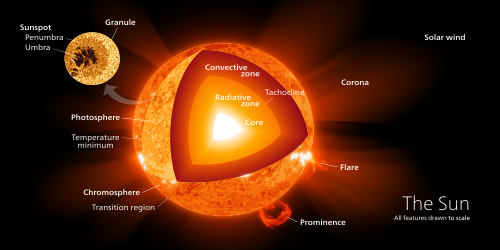The Sun
(Sun: Internal structure,Formation,Core)
The Sun is a G-type main-sequence star (G2V) based on its spectral class. As such, it is informally referred to as a yellow dwarf. It formed approximately 4.6 billion years ago from the gravitational collapse of matter within a region of a large molecular cloud. Most of this matter gathered in the center, whereas the rest flattened into an orbiting disk that became the Solar System. The central mass became so hot and dense that it eventually initiated nuclear fusion in its core. It is thought that almost all stars form by this process.
The Sun is roughly middle-aged; it has not changed dramatically for more than four billion[a] years, and will remain fairly stable for more than another five billion years. After hydrogen fusion in its core has diminished to the point at which it is no longer in hydrostatic equilibrium, the core of the Sun will experience a marked increase in density and temperature while its outer layers expand to eventually become a red giant. It is calculated that the Sun will become sufficiently large to engulf the current orbits of Mercury and Venus, and render Earth uninhabitable.
The enormous effect of the Sun on Earth has been recognized since prehistoric times, and the Sun has been regarded by some cultures as a deity. The synodic rotation of Earth and its orbit around the Sun are the basis of the solar calendar, which is the predominant calendar in use today.
Sunlight
The Sun's color is white, with a CIE color-space index near (0.3, 0.3), when viewed from space or when the Sun is high in the sky. When measuring all the photons emitted, the Sun is actually emitting more photons in the green portion of the spectrum than any other. When the Sun is low in the sky, atmospheric scattering renders the Sun yellow, red, orange, or magenta. Despite its typical whiteness, most people mentally picture the Sun as yellow; the reasons for this are the subject of debate. The Sun is a G2V star, with G2 indicating its surface temperature of approximately 5,778 K (5,505 °C, 9,941 °F), and V that it, like most stars, is a main-sequence star. The average luminance of the Sun is about 1.88 giga candela per square metre, but as viewed through Earth's atmosphere, this is lowered to about 1.44 Gcd/m2.[d] However, the luminance is not constant across the disk of the Sun (limb darkening).
Core
The structure of the Sun
 The core of the Sun extends from the center to about 20–25% of the solar radius. It has a density of up to 150 g/cm3
(about 150 times the density of water) and a temperature of close to
15.7 million kelvins (K). By contrast, the Sun's surface temperature is
approximately 5,800 K. Recent analysis of SOHO mission data favors a
faster rotation rate in the core than in the radiative zone above.
Through most of the Sun's life, energy has been produced by nuclear
fusion in the core region through a series of steps called the p–p
(proton–proton) chain; this process converts hydrogen into helium. Only
0.8% of the energy generated in the Sun comes from the CNO cycle, though
this proportion is expected to increase as the Sun becomes older.
The core of the Sun extends from the center to about 20–25% of the solar radius. It has a density of up to 150 g/cm3
(about 150 times the density of water) and a temperature of close to
15.7 million kelvins (K). By contrast, the Sun's surface temperature is
approximately 5,800 K. Recent analysis of SOHO mission data favors a
faster rotation rate in the core than in the radiative zone above.
Through most of the Sun's life, energy has been produced by nuclear
fusion in the core region through a series of steps called the p–p
(proton–proton) chain; this process converts hydrogen into helium. Only
0.8% of the energy generated in the Sun comes from the CNO cycle, though
this proportion is expected to increase as the Sun becomes older.The core is the only region in the Sun that produces an appreciable amount of thermal energy through fusion; 99% of the power is generated within 24% of the Sun's radius, and by 30% of the radius, fusion has stopped nearly entirely. The remainder of the Sun is heated by this energy as it is transferred outwards through many successive layers, finally to the solar photosphere where it escapes into space as sunlight or the kinetic energy of particles.
The proton–proton chain occurs around 9.2×1037 times each second in the core, converting about 3.7×1038 protons into alpha particles (helium nuclei) every second (out of a total of ~8.9×1056 free protons in the Sun), or about 6.2×1011 kg/s. Fusing four free protons (hydrogen nuclei) into a single alpha particle (helium nucleus) releases around 0.7% of the fused mass as energy, so the Sun releases energy at the mass–energy conversion rate of 4.26 million metric tons per second (which requires 600 metric megatons of hydrogen ), for 384.6 yottawatts (3.846×1026 W), or 9.192×1010 megatons of TNT per second. Theoretical models of the Sun's interior indicate a power density of approximately 276.5 W/m3, a value that more nearly approximates that of reptile metabolism or a compost pile than of a thermonuclear bomb.
The fusion rate in the core is in a self-correcting equilibrium: a slightly higher rate of fusion would cause the core to heat up more and expand slightly against the weight of the outer layers, reducing the density and hence the fusion rate and correcting the perturbation; and a slightly lower rate would cause the core to cool and shrink slightly, increasing the density and increasing the fusion rate and again reverting it to its present rate.









0 comments:
Post a Comment